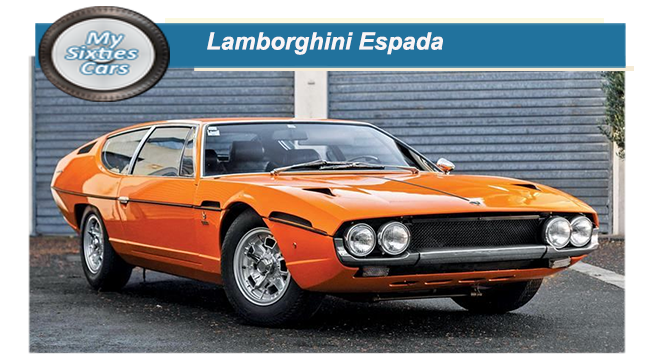
Once again, Marcello Gandini, the renowned Italian car designer, kingpin of the automotive design house Gruppo Bertone was responsible for the newest Lamborghini model, the Espada, reportedly having been inspired by another Bertone creation, the rear-engined Marzal show car.
Long, low and wide, the front-engine Espada rode a pressed-steel platform chassis with a 104.3-inch wheelbase and carried its power plant nearly eight inches farther forward than in the 400 GT.
Under the hood was the same 3929-cc engine that powered the 400 GT coupe, although this time using six Weber carburettors.
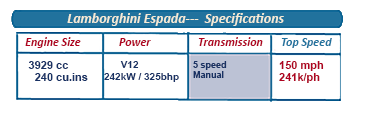 The Espada’s gutsy 244-cubic-inch (4quad-cam V12 engine meant the Espada became the world's fastest sedan (saloon) car when launched in 1968.
The Espada’s gutsy 244-cubic-inch (4quad-cam V12 engine meant the Espada became the world's fastest sedan (saloon) car when launched in 1968.
Lamborghini fitted a five-speed gearbox was standard, as usual (though Chrysler's TorqueFlite would become available in later versions of the Espada).
Named after 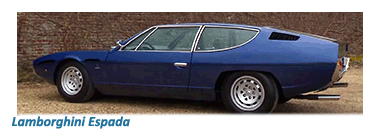 a matador's dagger, the wide-tracked, low-slung Espada was as good looking a car as Lamborghini produced during their history, and certainly the best of the Sixties.
a matador's dagger, the wide-tracked, low-slung Espada was as good looking a car as Lamborghini produced during their history, and certainly the best of the Sixties.
With four bucket seats and a well-trimmed interior, the Espada was classed as an "executive express" rather than a sports tourer, slotting neatly into Lamborghini's lineup in the mid to late Sixties, alongside the Islero and Miura.
The Espada's low and wide front end, with quad round headlamps at the ends of a blacked-out grille, was taller than that of the Miura, and the wide hood displayed dual NACA ducts.
![]()
 gave an impression of luxury that was wholly appropriate, with walnut trim and generous use of leather.
The Sspada's four buckets seats were comfortable, all with built-in headrests.
gave an impression of luxury that was wholly appropriate, with walnut trim and generous use of leather.
The Sspada's four buckets seats were comfortable, all with built-in headrests. 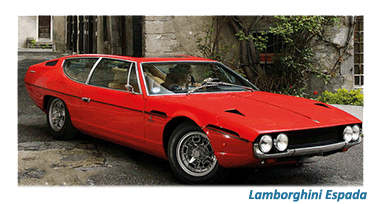 There was just enough space in the rear for the car to be considered (more or less) a four-seater rather than a tight 2+2
>A large centre console divided the interior — it was so large that one might have suspected a backbone chassis, and it did increase frame strength as well as carrying ventilation ducts.
The Espada's handling was neutral, cornering powers were high, and there was little body roll.
An extra glass panel below the back window readically improved rearward visibility past the chopped-off tail. In profile, the car displayed a nearly-horizontal roofline-into-backlight line, with a rear kick up past its low belt line.
Hood and upper fenders tilted forward for engine access.
There was just enough space in the rear for the car to be considered (more or less) a four-seater rather than a tight 2+2
>A large centre console divided the interior — it was so large that one might have suspected a backbone chassis, and it did increase frame strength as well as carrying ventilation ducts.
The Espada's handling was neutral, cornering powers were high, and there was little body roll.
An extra glass panel below the back window readically improved rearward visibility past the chopped-off tail. In profile, the car displayed a nearly-horizontal roofline-into-backlight line, with a rear kick up past its low belt line.
Hood and upper fenders tilted forward for engine access.
![]()
The broad flat bonnet, the only significant body item fabricated in aluminium, fitted tightly onto the V12, which filled the engine compartment, while its surface was broken by two NACA ducts, for the cabin ventilation system.
Engine air was taken in through the nose and exhausted through slots on the sides. Twin lights neatly flanked the plain grille.
The large c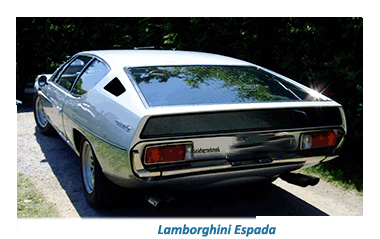 onventional doors provided reasonable access to the rear seats, and side windows were adequate (the small rear pair were top-hinged).
onventional doors provided reasonable access to the rear seats, and side windows were adequate (the small rear pair were top-hinged).
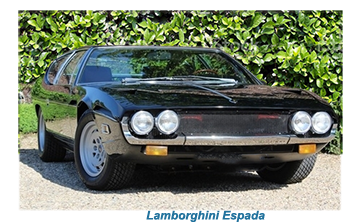 In general, visibility was better than for most `supercars' of the period.
In general, visibility was better than for most `supercars' of the period.
The tail treatment was smart, for, in addition to the sizeable sloping glass tailgate, there was a full-width vertical glass panel right at the back, which made for easy reversing (a manoeuvre some supercar stylists forget).
The battery and the spare wheel sat below the luggage deck, which was quite large, although shallow, meaning that the load was restricted.
Lamborghini did provide some compensation for this shortcoming by offering fitted suitcases although only as an optional extra.
Famous Espada owners have included the Shah of Iran, the novelist Alistair McLean, and known Lamborghini lover Sir Paul McCartney.
The Espada was a tremendous commercial and critical success for Lamborghini, putting them very much on the map, with sales of more than 1200 surpassing all the other Sixties models put together.






